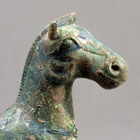J.J. Lally & Co., Oriental Art / New York City, New York
MenuPast Exhibition
Bronze and Gold in Ancient China
March 24 - April 12, 2003
10.
A BRONZE FIGURE OF A STALLION
Warring States period, 4th/3rd Century B.C.
well modelled in a simplified realistic style and with a brilliantly colored surface patina, shown standing with head high, facing front with an alert expression in the large eyes, the muzzle nearly flat on top and with prominent flared nostrils, the cropped mane shown as a bristled ridge tapering down from a thick wedge-shaped crown between the pricked-up ears, the broad back and flanks smoothly contoured and the slender legs each ending in a well-defined fetlock above a rounded hoof, the tail bound into a knot at the end and the sex of the horse clearly indicated, the solid bronze with malachite green, cuprite red and lapis blue surface corrosion brightly mottled all over, and with extensive remains of finely woven silk on the rump and under the belly, the muscular chest with remains of fabric straps and a corroded bronze and iron medallion.
Height 4 3⁄4 inches (12.1 cm)
Length 5 1⁄4 inches (13.4 cm)
Compare the two Warring States period bronze horses in the Nelson-Atkins Museum, Kansas City, illustrated in The Nelson Atkins Museum of Art: A Handbook of the Collection, New York, 1993, p. 281.
Another Warring States period bronze horse of larger size, in the Palace Museum, Beijing, is illustrated in Zhongguo Meishu Quanji, Diaosubian (Compendium of Chinese Works of Art, Sculpture), Vol. 1, Neolithic to Warring States, Beijing, 1988, p. 126, no. 156 with description on p. 49.
Compare also the more stylized bronze figure of a horse which was excavated in 1978 from a Warring States tomb at Pingyin county, Shandong province and now is in the Shandong Pingyin County Museum, published in Zhongguo Qingtongqi Quanji (Compendium of Chinese Bronzes), Vol. 9, Eastern Zhou, section 3, Beijing 1997, no. 47, illustrated on p. 50, with description on p. 16.
